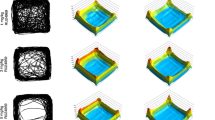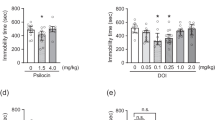Abstract
Rationale
Activation of one or more of the serotonin (5-HT) receptors may play a role in mediating the antidepressant effects of SSRIs.
Objective
The present studies were conducted to evaluate the effects of the novel 5-HT2C receptor agonist WAY-163909 in animal models of antidepressant activity (forced swim test (FST), resident–intruder, olfactory bulbectomy (BULB)), in a schedule-induced polydipsia (SIP) model of obsessive–compulsive disorder and in a model for evaluating sexual dysfunction.
Results
WAY-163909 (10 mg/kg, i.p. or s.c.) decreased immobility time in Wistar–Kyoto rats in the FST, effects that were reversed by the 5-HT2C/2B receptor antagonist SB 206553. Moreover, in Sprague-Dawley rats, the profile of WAY-163909 (decreased immobility, increased swimming) in the FST was comparable to the effects of SSRIs. Acute treatment with WAY-163909 (0.33 mg/kg, s.c.) decreased rodent aggression at doses lower than those required for decreasing total behavior. Administration of WAY-163909 (3 mg/kg, i.p.) for 5 or 21 days decreased the BULB-induced hyperactivity in rats. Additionally, acute administration of WAY-163909 (3 mg/kg, i.p.) decreased adjunctive drinking in a SIP model. The effects of WAY-163909 were reversed by the 5-HT2C/2B receptor antagonist SB 206553 and the selective 5-HT2C receptor antagonist SB 242084. Chronic administration of WAY-163909 produced deficits in sexual function at doses higher (10 mg/kg, i.p.) than those required for antidepressant-like effects in the BULB model.
Conclusions
Taken together, these results demonstrate that the novel 5-HT2C receptor agonist WAY-163909 produces rapid onset antidepressant-like effects in animal models and may be a novel treatment for depression.





Similar content being viewed by others
Abbreviations
- SSRI:
-
serotonin reuptake inhibitor
- BULB:
-
olfactory bulbectomy
- 5-HT:
-
serotonin
- FST:
-
forced swim test
- (7bR,10aR)-1,2,3,4,8,9,10,10a-octahydro-7bH-cyclopenta-[b][1,4]-diazepino[6,7,1hi]indole:
-
WAY-163909
- ANOVA:
-
analysis of variance
- SEM:
-
standard error of the mean
- DRL:
-
differential reinforcement of low rate
- LSD:
-
least significant difference
- OCD:
-
obsessive–compulsive disorder
- SIP:
-
schedule-induced polydipsia
- SD:
-
Sprague-Dawley
- WKY:
-
Wistar-Kyoto
References
Beyer CE, Boikess S, Luo B, Dawson LA (2002) Comparison of the effects of antidepressants on norepinephrine and serotonin concentrations in the rat frontal cortex: an in-vivo microdialysis study. J Psychopharmacol 16:297–304
Bickerdike MJ, Adams DR, Bentley J, Benwell KR, Cliffe IA, Kennett GA, Knight AR, Malcolm CS, Misra A, Quirk K, Roffey JRA, Dourish CT (2002) Radioligand binding profile and in vitro functional efficacy of VER-3323, a novel 5-HT2C/5-HT2B receptor agonist. 5th IUPHAR Satellite Meeting on Serotonin
Bos M, Jenck F, Martin JR, Moreau JL, Sleight AJ, Wichmann J, Widmer U (1997) Novel agonists of 5HT2C receptors. Synthesis and biological evaluation of substituted 2-(indol-1-yl)-1-methylethylamines and 2-(indeno[1,2-b]pyrrol-1-yl)-1-methylethylamines. Improved therapeutics for obsessive compulsive disorder. J Med Chem 15:2762–2769
Chou-Green JM, Holscher TD, Dallman MF, Akana SF (2003) Compulsive behavior in the 5-HT2C receptor knockout mouse. Physiol Behav 78:641–649
Clenet F, De Vos A, Bourin M (2001) Involvement of 5-HT2C receptors in the anti-immobility effects of antidepressants in the forced swimming test in mice. Eur Neuropsychopharmacol 11:145–152
Cremers TI, Giorgetti M, Bosker FJ, Hogg S, Arnt J, Mork A, Honig G, Bogeso K-P, Westerink B, den Boer BHC, Wikstrom HV, Tecott LH (2004) Inactivation of 5-HT(2C) receptors potentiates consequences of serotonin reuptake blockade. Neuropsychopharmacology 29:1782–1789
Cryan JF, Lucki I (2000) Antidepressant-like behavioral effects mediated by 5-hydroxytryptamine2C receptors. J Pharmacol Exp Ther 295:1120–1126
Cryan JF, McGrath C, Leonard BE, Norman TR (1998) Combining pindolol and paroxetine in an animal model of chronic antidepressant action—can early onset of action be detected? Eur J Pharmacol 352:23–28
Cryan JF, McGrath C, Leonard BE, Norman TR (1999) Onset of the effects of the 5-HT1A antagonist, WAY-100635, alone, and in combination with paroxetine, on olfactory bulbectomy and 8-OH-DPAT-induced changes in the rat. Pharmacol Biochem Behav 63:333–338
Dawson LA, Nguyen HQ, Smith DI, Schechter LE (2000) Effects of chronic fluoxetine treatment in the presence and absence of (±)pindolol: a microdialysis study. Br J Pharmacol 130:797–804
Detke MJ, Rickels M, Lucki I (1995) Active behaviors in the rat forced swimming test differentially produced by serotonergic and noradrenergic antidepressants. Psychopharmacology 119:47–54
Dunlop J, Sabb AL, Mazandarani H, Zhang J, Kalgaonker S, Shukhina E, Sukoff S, Vogel R, Stack G, Schechter L, Harrison BL, Rosenzweig-Lipson S (2005) WAY-163909 (7bR,10aR)-1,2,3,4,8,9,10,10a-octahydro-7bH-cyclopenta-[b][1,4]-diazepino[6,7,1hi]indole); A novel 5-HT2C receptor selective agonist with anorectic activity. J Pharmacol Exp Ther 313(2):862–869
Dunlop J, Marquis M, Kim HL, Leung L, Kao J, Cheesman C, Rosenzweig-Lipson S (2006) Pharmacological profile of the 5-HT2C receptor agonist WAY-163909 ((7bR,10aR)-1,2,3,4,8,9,10,10a-octahydro-7bH-cyclopenta-[b][1,4]diazepino[6,7,1hi]indole); therapeutic potential in multiple indications. CNS Drug Review 12:167–176
Freo U, Holloway HW, Greig NH, Soncrant TT (1992) Chronic treatment with meta-chlorophenylpiperazine (m-CPP) alters behavioral and cerebral metabolic responses to the serotonin agonists m-CPP and quipazine but not 8-hydroxy-2(di-N-propylamino)tetralin. Psychopharmacology 107:30–38
Harkin A, Kelly JP, McNamara M, Connor TJ, Dredge K, Redmond A, Leonard BE (1999) Activity and onset of action of reboxetine and effect of combination with sertraline in an animal model of depression. Eur J Pharmacol 364:123–132
Hayashi A, Sonoda R, Kimura Y, Takasu T, Suzuki M, Sasamata M, Miyata K (2004) Antiobesity effect of YM348, a novel 5-HT2C receptor agonist in Zucker rats. Brain Res 1011:221–227
Hogg S, Dalvi A (2004) Acceleration of onset of action in schedule-induced polydipsia: combinations of SSRI and 5-HT1A and 5-HT1B receptor antagonists. Pharmacol Biochem Behav 77:69–75
Kelly JP, Wrynn AS, Leonard BE (1997) The olfactory bulbectomized rat as a model of depression: an update. Pharmacol Ther 74:299–316
Kennedy AJ, Gibson EL, O’Connell MT, Curzon G (1993) Effects of housing, restraint and chronic treatments with mCPP and sertraline on behavioural responses to mCPP. Psychopharmacology 113:262–268
Kennett GA, Wood, MD, Bright F, Trail B, Riley G, Holland V, Avenell KY, Stean T, Upton N, Bromidge S, Forbes IT, Brown AM, Middlemiss DN, Blackburn TP (1997) SB 242084, a selective and brain penetrant 5-HT2C receptor antagonist. Neuropharmacology 36:609–620
Kennett GA, Trail B, Bright F (1998) Anxiolytic-like actions of BW 723C86 in the rat Vogel conflict test are 5-HT2B mediated. Neuropharmacology 36:609–620
Kimura Y, Hatanaka K, Naitou Y, Maeno K, Shimada I, Koakutsu A, Wanibuchi F, Yamaguchi T (2004) Pharmacological profile of YM348, a novel, potent and orally active 5-HT2C receptor agonist. Eur J Pharmacol 283:37–43
Leyson D, Kelder J (1998) Ligands for the 5-HT2C receptor as potential antidepressants and anxiolytics. In: van der Groot J (ed) Trends in drug research. Elsevier, Amsterdam, pp 49–61
Mar A, Spreekmeester E, Rochford J (2000) Antidepressants preferentially enhance habituation to novelty in the olfactory bulbectomized rat. Psychopharmacology 150:52–60
Marquis K, Sabb A, Logue SF, Stack G, Brennan JA, Piesla MJ, Comery TA, Grauer SM, Ashby CR, Nguyen HQ, Dawson LA, Stack G, Meltzer HY, Harrison BL, Rosenzweig-Lipson S (2007) WAY-163909 ((7bR,10aR)-1,2,3,4,8,9,10,10a-octahydro-7bH-cyclopenta-[b][1,4]diazepino[6,7,1hi]indole): a novel 5-HT2C receptor selective agonist with preclinical antipsychotic-like activity. J Pharmacol Exp Ther 320:486–496
Martin JR, Bos M, Jenck F, Moreau J, Mutel V, Sleight AJ, Wichmann J, Andrews JS, Berendsen HH, Broekkamp CL, Ruigt GS, Kohler C, Delft AM (1998) 5-HT2C receptor agonists: pharmacological characteristics and therapeutic potential. J Pharmacol Exp Ther 286:913–924
McCall RB, Franklin SR, Hyslop DK, Knauer CS, Chio CL, Haber CL, Fitzgerald LW (2001) PNU-22394, a 5-HT2C receptor agonist, reduces feeding in rodents and produces weight loss in humans. Soc Neurosci Abstr 27:309.2
Mitchell PJ, Redfern PH (1992) Acute and chronic antidepressant drug treatments induce opposite effects in the social behaviour of rats. J Psychopharmacol 6:241–257
Mitchell PJ, Redfern PH (2000) Effects of m-chlorophenylpiperazine and mesulergine on rodent agonistic behaviour. J Psychopharmacol 14:A32 (PD2)
Mitchell PJ, Redfern PH (2005) Animal models of depressive illness: the importance of chronic drug treatment. Curr Pharm Des 11:171–203
Moreau JL, Jenck F, Martin JR, Perrin S, Haefely WE (1993) Effects of repeated mild stress and two antidepressant treatments on the behavioral response to 5HT1C receptor activation in rats. Psychopharmacology 110:140–144
Moreau J-L, Bos M, Jenck F, Martin JR, Mortas P, Wichmann J (1996) 5HT2C receptor agonists exhibit antidepressant-like properties in the anhedonia model of depression in rats. Eur Neuropharmacol 6:169–175
Porsolt RD, Le Pichon M, Jalfre M (1977) Depression: a new animal model sensitive to antidepressant treatments. Nature 266:730–732
Redmond AM, McNamara MG, Dredge K, Kelly JP, Leondard BE (1997) Onset of action of venlafaxine, citalopram, and desipramine in the OB rat model of depression. J Psychopharmacol 11:A40
Rosenzweig-Lipson S, Beyer C, Malberg J, Lin Q, Ashby CR, Graf R, Sung A, Grauer S, Logue S (2005) WAY-163909, a 5-HT2C selective agonist for the treatment of obesity, depression and schizophrenia: lack of tolerance. SFN Itinerary Viewer
Rosenzweig-Lipson S, Zhang J, Mazandarani H, Harrison BL, Sabb A, Sabalski J, Stack G, Welmaker G, Barrett JE, Dunlop J (2006) Antiobesity-like effects of the 5-HT2C receptor agonist WAY-161503. Brain Res 1073–1074:240–251
Rosenzweig-Lipson S, Beyer CE, Hughes ZA, Khawaja X, Rajarao SJ, Malberg JE, Rahman Z, Ring RH, Schechter LE (2007) Differentiating antidepressants of the future: efficacy and safety. Pharmacol Ther 113:134–153
Sabb AL, Vogel RL, Welmaker G, Sabalski JE, Coupet J, Dunlop J, Rosenzweig-Lipson S, Harrison B (2004) Cycyloalkyl[b][1,4]benzodiazepinoindoles are agonists at the human 5-HT2C receptor. Bioorg Med Chem Lett 14:2603–2607
Sukoff Rizzo SJ, Schechter LE, Rosenzweig-Lipson S (2007) A novel approach for predicting antidepressant-induced sexual dysfunction in rats. Psychopharmacology, in press
Vickers SP, Benwell KR, Porter RH, Bickerdike MJ, Kennett GA, Dourish CT (2000) Comparative effects of continuous infusion of mCPP, Ro 60–0175 and d-fenfluramine on food intake, water intake, body weight and locomotor activity in rats. Br J Pharmacol 130:1305–1314
Vickers SP, Easton N, Webster LJ, Wyatt A, Bickerdike MJ, Dourish CT, Kennett GA (2003) Oral administration of the 5-HT2C receptor agonist, mCPP, reduces body weight gain in rats over 28 days as a result of maintained hypophagia. Psychopharmacology 167:274–280
Welmaker GS, Nelson JA, Sabalski JE, Sabb AL, Potoski JR, Graziano D, Kagan K, Coupet J, Dunlop J, Mazandarani H, Rosenzweig-Lipson S, Sukoff S, Zhang Y (2000) Synthesis and 5-Hydroxytryptamine (5-HT) activity of 2,3,4,4a-tetrahydro-1H-pyrazino[1,2-a]quinoxalin-5-(6H)ones and 2,3,4,4a,5,6-hexahydro-1H-pyrazino[1,2-a]quinoxalines. Bioorg Med Chem Lett 10:1991–1994
Woods A, Smith C, Szewczak M, Dunn RW, Cornfeldt M, Corbett R (1993) Selective serotonin reuptake inhibitors decrease schedule-induced polydipsia in rats: a potential model for obsessive–compulsive disorder. Psychopharmacology 112:195–198
Acknowledgements
The authors would like to thank Menelas Pangalos and Ron Magolda for their unwavering support of 5-HT2C agonist studies.
Author information
Authors and Affiliations
Corresponding author
Rights and permissions
About this article
Cite this article
Rosenzweig-Lipson, S., Sabb, A., Stack, G. et al. Antidepressant-like effects of the novel, selective, 5-HT2C receptor agonist WAY-163909 in rodents. Psychopharmacology 192, 159–170 (2007). https://doi.org/10.1007/s00213-007-0710-6
Received:
Accepted:
Published:
Issue Date:
DOI: https://doi.org/10.1007/s00213-007-0710-6




